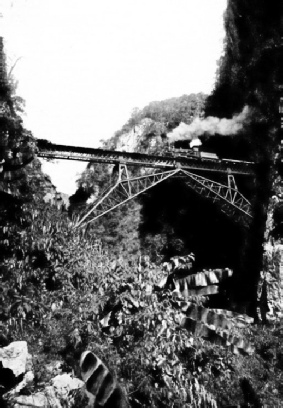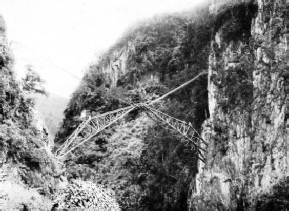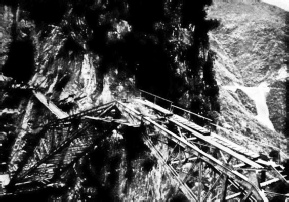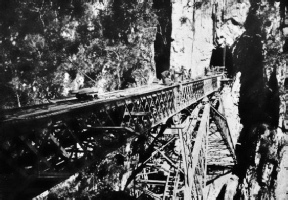

The Great Yunnan Railway
How French engineers have conquered nature and laid the Great Yunnan Railway in wild China

THE FAUX NAM-
WHEN the French nation finally made its peace with China on June 9th, 1885, after some three years’ persistent conquest in the south-
However, as the situation became understood, it was realised that France had secured a decided strategical advantage, because it was an excellent point where-
The French Government, thereupon advanced a project for continuing the line 300 miles up country to Yunnan fu, the capital of the province. It was admitted to be a daring undertaking, bearing in mind the peculiar physical characteristics, yet was imperative for the success of Indo-
As a result of prolonged deliberations, China finally acquiesced in the proposal, and upon exceedingly favourable terms. The undertaking was to be completed, either by the French Government or by any private company to which the latter might feel disposed to hand over the concession. France was to find the money; the Celestial Government merely was to convey, free of all expenditure, the strip of land requisite for the right-
When the deliberations between the two Governments were adjusted satisfactorily, French financiers, in combination with constructional engineers, expressed their willingness to complete the undertaking, and to work it for the French Government, providing a sufficiently attractive financial arrangement could be completed between private and official interests. The former wanted to take over the concession lock, stock and barrel. The suggestion was received favourably, and a commission was dispatched to the East to investigate the problems on the spot, so that an estimate of the cost of the railway might be obtained.
The members of this commission did not bring back a very encouraging story. Apart from the formidable physical difficulties which would have to be overcome, and the many abstruse technical problems which would have to be solved, they laid emphasis upon the dearth of native labour, the troubles that would arise in maintaining the commissariat of the camps in the interior, and the heavy expenses that would be incurred in regard to transporting material to the grade.
The project was threshed out thoroughly with the assistance of the information gained on the spot, the French Government estimating that the scheme could be fulfilled for £3,840,000 for some 290 miles. The concession was transferred to private interests, which were to construct and operate the railway at their own expense for a term of seventy-
When the financial terms were completed a hitch arose. The concessionaires did not regard the projected route of the line with favour, as it was found to introduce a ruling grade of 3·5 per cent -
Thereupon fresh surveys were made, and at last a new route was discovered. On paper it certainly appeared to be preferable to the original location, inasmuch as on the heaviest part of the mountain section, 53 miles in length, the ruling grade was reduced to 2·5 per cent -
Another apparent advantage, as compared with the first location, was the fact that whereas the latter introduced a maximum grade of 132 feet per mile in the Pataho River basin, on the new survey this maximum was pulled down to 1·5 per cent -
The line is of metre gauge (3 feet 3⅓ inches), and the 50-
The plotting of the line necessitated throwing the metals from cliff-
The question of bridging this chasm expeditiously and inexpensively puzzled the engineers. Ordinary bridge-
Finally a solution was offered by M. Paul Bodin, the chief engineer to the Societe de Construction des Batignolles. His suggestion for a steel bridge was certainly novel, but as none better was forthcoming it was adopted. It comprised the fashioning of two bascules, one on either side of the gorge, which were to be lowered after erection until they met and were connected in the centre. Upon this inverted V-

THE BASCULES OF THE FAUX NAM-
It was an ingenious idea, and, as events proved, it solved the problem very completely. The grade was driven through the cliff face on the railhead side, so that the tunnel overlooked the gulch. Men then descended the cliff face to a suitable point immediately below the bore, and prepared the foundations for the anchorages of the bascule. It was slow and dangerous work, as the precipice was steep. Considerable time was occupied in chipping away the rock, so as to permit movement between the tunnel and the foundations by means of ladders. Simultaneously, other toilers scaled the cliff face with ladders to a point immediately above the tunnel, where the rock face was scooped out to form a big cave. Here a windlass was rigged up, which was used for lowering the required material to the men working upon the foundations.
These preparations had to be completed on each side of the chasm, although on the north face the toilers were not cramped so severely, seeing that this precipice sheers upwards at a sharp angle, instead of vertically. Thus the men were able to contrive a platform in front of the tunnel mouth from which to pursue their tasks, whereas on the south side everything had to be conducted from the tunnel portal itself.
Seeing that the railhead was some 20 miles to the rear when the bridge was commenced, the engineers were hampered very seriously by lack of transport facilities. There was only a primitive wagon road, such as is laid often in such undertakings to feed the camps ahead of the end of steel with material, men, etc., but this failed to meet the situation. Animals for transport service were difficult to obtain, so coolies had to be pressed into service as carriers. Under these circumstances the weight of the component pieces of the steelwork had to be kept down very rigorously, but it was found impossible to reduce certain sections to less than 13 hundredweight. With such weights, and advancing over broken ground, large gangs of coolies were required to handle the heaviest and bulkiest pieces of steel.
Each bascule was built vertically like a tower from its anchorage up the cliff face, the steel being held in this position by cables made fast upon and passed down from the uppermost working ledge. When the steelwork of both bascules was completed, the latter reared up in front of the tunnel mouths like metallic trestles or towers. Arrangements then were completed for lowering the two sections simultaneously until they came together dead in the desired position over the gorge. The cables attached to the upper end of each tower were paid out slowly and evenly from the windlasses on each side, the riveters, sitting astride the tower ends, guiding the descent of the pieces. The actual lowering operation took four hours. When at last the ends came together and were adjusted they were connected up, and by aid of wooden plankways temporary communication was provided between the opposing cliff faces. It was a delicate and ingenious operation, which, however, was fulfilled with complete success.
Once the legs of steel had been set the erection of the bridge proper proceeded apace. Short steel towers were built on the humps of the bascules to support the deck. The spans of the latter were erected in the tunnel, and then launched over rollers by the aid of cables, until they came into the requisite position. From end to end the bridge measures 220 feet 4 inches at the track level; the distance between the heels of the bascules is 180½ feet; and the rails are laid 335 feet above the bed of the river below.
While the Faux Nam-
The cracks, crevices, and rifts in the mountain flanks also proved serious obstacles. In order to preserve the alignment and grade it was necessary to throw heavy retaining walls across these interruptions, filling the space behind with masses of rock and debris which had been brought down from higher levels by the disintegrating forces of Nature. Unless careful attention were devoted to the adequate draining of the ground behind these walls disaster was inevitable. On one occasion, where a large wall had been thrown across a hollow and filled in to grade level, the whole collapsed under the weight of a passing construction train, the engine breaking away from its couplings and pitching into the river some 50 feet below, owing to the water having undermined the foundations of the earthworks.

THE BASCULES OF THE FAUX NAM-
When the railway was commenced the engineers somewhat underestimated the force and effect of these sliding movements, and the protective walls proved too weak for their purpose. Many cracked, or were burst outwards by the weight and sliding pressure behind, with the result that they had to be demolished and rebuilt upon a heavier scale. The torrential rains also played sad havoc with the best of designs time after time. Miniature torrents poured down the gullies, scarring the steep mountain slopes or soaking into the ground to flow through cracks and crevices in the main mass of rock, effecting their escape behind the walls, where they were pent up until at last the force exerted by the accumulating water caused the walls to bulge outwards and be carried away by the suddenly released pressure. As these disturbing factors, in many instances, did not reveal themselves until some time after the work had been completed, the engineers were kept on tenterhooks. The completed portion of the line had to be watched vigilantly so as to enable repairs and reinforcing to be carried out directly signs of weakness became manifest.
But the rock slides constituted one of the most implacable foes. A mountain spur or crag which appeared able to defy the elements for centuries would collapse suddenly, and, coming down, would smash the permanent way to fragments, or bury it completely. On one occasion over 100,000 tons of rock got loose in this manner, and having a clear helter-
In order to save time in reconstruction, and to permit the construction trains to cross the breach, so as to keep the camps beyond the railhead adequately supplied, the engineer hurriedly constructed a light metal bridge which he rolled across the gap. It served its purpose for the time being, and stood securely while a massive structure of concrete was built beneath, the cavity being filled up completely in this manner. Even this heroic expedient did not fail to be subjected to a heavy pounding, as another landslip caught it, and knocked it about somewhat badly, but this damage was repaired speedily.
In 1906 the enterprise was brought face to face with threatened disaster. The interests which had undertaken the constructional operations succumbed to the long string of difficulties and troubles which beset the work. It was seen that the original would prove completely in-
The rainfall, the insalubrity of the climate, the shortage of labour, and the difficulty in handling material owing to the absence of existing highways superior to rough cart-
The labour troubles were endless. Emissaries had to be sent out far and wide to recruit coolies for the grade. As these were all Chinese, and worked under Chinese middlemen, some time elapsed before the French engineers became familiar with the peculiar prevailing conditions. The middlemen, resolved to make an excellent thing for themselves out of the transaction, sweated the labourers, thereby diverting the greater proportion of the money disbursed under wages into their own pockets. Quarrels between the coolies and their “bosses” were of repeated occurrence. Riots broke out among the men, who became dissatisfied with the small pittance they received, owing to the avariciousness of the labour contractors, and considerable damage was done from time to time to the railway property. Once or twice the disaffection assumed the proportions of Avell-

RIVETING UP THE TRACK DECK OF THE FAUX NAM-
Despite these exasperating difficulties and delays the railway was carried to its inland terminus at Yunnan-
A curious circumstance was revealed upon the completion of the enterprise. India has a rich trade with Yunnan, especially in cotton cloth and yarns. This traffic has been conducted overland from its beginning. When the railway was opened it was surmised that this overland business would cease, and constitute a source of revenue to the steel highway, reaching Yunnan via water from Indian ports to Haiphong, and thence over the new line. But the first year’s working of the railway did not make the slightest impression upon the overland transportation from India. The merchants continued to dispatch their goods on the backs of animals by the circuitous difficult journey of 32 days over dangerous trails and rugged mountain paths; and, what was a more disturbing factor, could place them in Yunnan-
A certain hostility to the line exists among the Chinese of the interior. This attitude is somewhat explicable, since not only are the railway transport charges somewhat high, but a “transit tax” is levied upon all foreign goods, which are not of French or Indo-
The French, however, view the future with buoyant optimism, confident that in a few years the traffic will have developed to such a potential degree as to render the railway highly profitable. The only adverse forces which they fear are those of Nature, who in her playfulness may overwhelm the narrow line from time to time, thereby not only throwing traffic all sixes and sevens, but offering the engineers some costly and baffling puzzles of a technical character.
You can read more on
and
and
“Travelling by Train in China”
on this website.